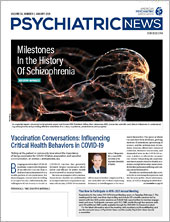In late November 2020, New York City announced that all public schools would return to total online learning due to the rising number of COVID-19 cases in the city. Parent-organized protests quickly appeared outside City Hall, as families were given less than 24 hours’ notice to prepare their children for full-time remote instruction and find child care arrangements. Many child and adolescent patients, as well as their parents, have expressed frustration.
The switch from online learning to hybrid then back to online has caused a lot of confusion and fear for parents and kids alike. This is in no small part due to the inconsistent and unclear messages we are hearing from our legislators. However, there is much we need to do as mental health professionals to support our patients during these difficult times.
The mental health sequelae of the isolation, illness, and economic consequences (to name but a few factors) accompanying the COVID-19 pandemic have been well documented. However, this national milieu has also created specific mental health challenges for youth. According to reports from the Centers for Disease Control and Prevention, the proportion of children’s mental health–related visits to emergency departments (ED) among all pediatric ED visits increased in April 2020 and remained elevated through October 2020. Compared with 2019, the proportion of mental health–related visits for children aged 5 to 11 and 12 to 17 years increased approximately 24% and 31%, respectively.
The disruptions of schools nationwide is likely no small part of this worsening picture of mental health. The social consequences experienced by children were described in the May 20, 2020, New York Times: “The shuttering of the American education system severed students from more than just classrooms, friends, and extracurricular activities. It has also cut off an estimated 55 million children and teenagers from school staff members whose open doors and compassionate advice helped them build self-esteem, navigate the pressures of adolescence, and cope with trauma.”
Despite the availability of remote peer communication through technology and social media, the isolating circumstances of the pandemic appear to be impacting children through increased levels of anxiety, depression, and even suicidal ideation. Parents are reporting that their children are more withdrawn than usual, with accompanying decreases in sleep and appetite. Others described decreased social opportunities for their kids and concern about their being constantly online. The loss of school as a crucial forum to interact with peers and authority figures diminishes children’s ability to develop vital social and emotional skills. Perhaps even more concerning, there is the potential for some teenagers to self-medicate. Some adolescent patients have commented that their parents’ medicine cabinet is a great source of Xanax and Valium.
Adding to this in many cases is the further disruption resulting from the transitions from online learning to in-person then back to online. Those struggling with social anxiety can experience amplified avoidance or emotional outbursts with these repeated environmental changes.
In responding to these challenges, parents are a vital resource. However, many are struggling with how to assist their children. There are several key recommendations for our patients’ parents and guardians we should help propagate. First, parents need to be aware and recognize that children may be experiencing real loss and feelings of disconnection. Kids should be encouraged to identify their feelings—for example, “I am sad” or “I am lonely.” Likewise, parents can tell their children concrete observations—for example, “I have noticed you seem more angry” and “You are staying in your room more often.”
Second, parents need to give children a voice and validate their concerns. This can be done by inviting an honest discussion about how the pandemic is affecting their behavior. Examples can include changes in their sleep and eating patterns. Physical activity is another potential difficulty: Parents can offer exercise as part of a daily routine, even if it is something as simple as a 30-minute family walk. Children are very resilient, but they still need help in this unprecedented time.
Third, if needed, parents must feel empowered to seek professional psychiatric support, preferably with the child’s permission. Working together as a family toward a plan will make a challenging journey smoother in this unpredictable time.
The thoughtful removal of logistical and institutional barriers during the pandemic has allowed mental health professionals to use telehealth to expand access to care, including for children and adolescents. APA has consistently been a strong advocate for this. But more needs to be done. In the face of this unprecedented situation, we must continue to support, treat, and educate our patients and their families. More than that, there is a crucial and pressing imperative for psychiatry as a field to create additional interventions and preventive strategies to address the mental health impact on children and adolescents during the COVID-19 crisis. ■

